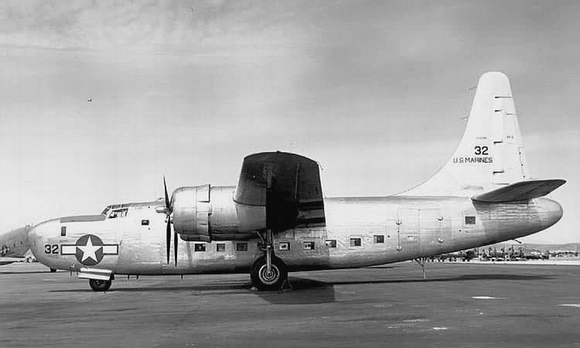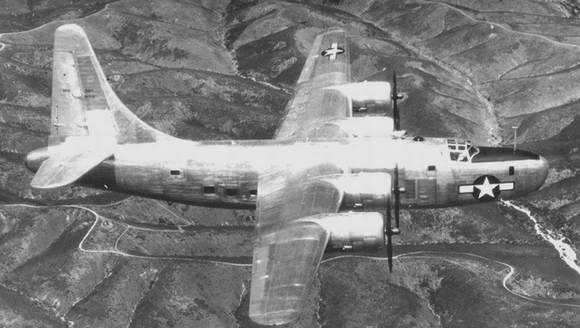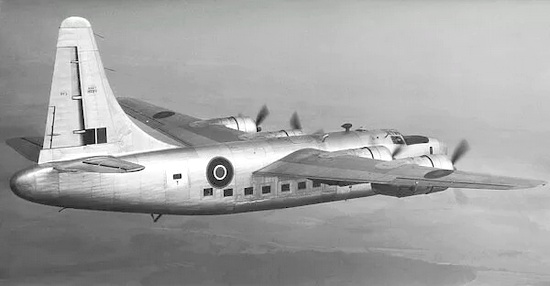The
RY-3 was the transport version of the PB4Y-2 Privateer. It was assigned the
company designation of Model 101. The RY-3 differed from the PB4Y-2 in having
no armament and in having a series of windows cut into the sides of the fuselage.
A large loading door was cut into the side of the rear fuselage, and fairings
were installed where the nose and tail turrets had been. A crew of four and 28
passengers could be carried. 16,641 pounds of cargo could be carried in the
all-freight configuration. A hinged nose allowed up to 1600 pounds of cargo to
be carried in the forward section.
The
Navy ordered 112 RY-3s in March of 1944, but only 34 RY-3s were actually built.
Only a few of these planes actually ended up serving with the Navy, primarily
being operated by the Marine Corps. Most of the RY-3s were delivered instead to
the Royal Air Force. 26 RY-3s were delivered to the RAF as Liberator C.IX
starting in February of 1945. RAF serials were JT973, JT975/JT998, and JV936).
They were assigned to Nos. 231 and 232 Squadrons of RAF Transport Command. The
famous Commando, which was LB-30 AL504, was also converted to single-tailed
RY-3 configuration in 1944.
At
the end of the war, the remaining RY-3s on the original order were cancelled,
including 63 more Liberator C.IXs intended for the RAF (JV937/JV999). Also
cancelled was a version for the USAAF designated C-87C.
The
RAF's experience with the Liberator C.IX was not a happy one. Three (including
Commando) were lost in fatal crashes, and there were speculations that there
was something basically wrong with the structural integrity of the aircraft.
All surviving RAF Liberator C.IXs except one were struck off charge in April of
1946 and either returned to the US Navy or else were scrapped. The sole
remaining Liberator C.IX (JT973, ex BuNo 90021) ended up flying ice-research
missions with the Royal Canadian Air Force under the auspices of the National
Research Council. It was given the name Rockcliffe Icewagon. It was kept flying
by scavenging spare parts from the Liberator stores, and later from the U.S.
Navy's PB4Y-2 inventory. Rockcliffe Icewagon flew her last mission in late
1948, when it was replaced by a Canadair North Star (Merlin-powered DC-4) and
scrapped.
Engines: Four
Pratt & Whitney R-1830-94 fourteen-cylinder unsupercharged air cooled
radial engines rated at 1350 hp.
Maximum speed:
248.5 mph at 12,000 feet
Cruising speed: 158
mph
Initial climb rate:
1180 feet per minute. An altitude of 10,000 feet could be reached in 16.3
minutes.
Service ceiling: 18,300
feet
Wingspan: 110
feet 0 inches
Length: 75 feet
5¼ inches
Height: 29 feet 0
inches
Wing area: 1048
square feet
Weights: 31,000
pounds empty, 60,000 pounds gross
Crew: four; 28
passengers could be carried
Cargo: 16,641
pounds could be carried in the all-freight configuration. A hinged nose allowed
up to 1600 pounds of cargo to be carried in the forward section.
Serials of Consolidated-Vultee
RY-3 Privateer
90020/90050 Consolidated-Vultee RY-3 Privateer
90021/90047 to RAF as JT973/JT999
90048 to RAF as JV936
90049/90050 to RAF as JV937/JV938 but never delivered
90051/90056 Cancelled contract for RY-3 Privateer. Were to
have gone to RAF as JV939/JV944
90057/90059 Consolidated-Vultee RY-3 Privateer. Were to have
gone to RAF as JV945/JV947 but were never delivered
90060/90131 Cancelled contract for RY-3 Privateer.
90060/90111 were to have gone to RAF as JV948/JV999
90132/90384 Cancelled contract for R2Y-1
Disposition of Liberator IX Delivered
Between January and July 1945
JT973 (BuNo 90021) 20/9/48 SOC
JT975 (BuNo 90023) 28/2/46 SOC
JT976 (BuNo 90024) 28/2/46 SOC
JT977 (BuNo 90025) -
JT978 (BuNo 90026) returned to US Navy 16/4/46
JT979 (BuNo 90027) Overshot landing at Whenaupai, New
Zealand 4/7/45
JT980 (BuNo 90028) -
JT981 (BuNo 90029) returned to US Navy 16/4/46
JT982 (BuNo 90030) Crashed in the Atlantic 4/7/45
JT983 (BuNo 90031) returned to US Navy 16/4/46
JT984 (BuNo 90032) returned to US Navy 16/4/46
JT985 (BuNo 90033) Hit hill in bad weather, Dorset, 15/6/45
JT986 (BuNo 90034) 28/2/46 SOC
JT987 (BuNo 90035) 28/2/46 SOC
JT988 (BuNo 90036) 28/2/46 SOC
JT989 (BuNo 90037) returned to US Navy 16/4/46
JT990 (BuNo 90038) 26/2/46 SOC
JT991 (BuNo 90039) returned to US Navy 16/4/46
JT992 (BuNo 90040) returned to US Navy 16/4/46
JT993 (BuNo 90041) 28/2/46 SOC
JT994 (BuNo 90042) 28/2/46 SOC
JT995 (BuNo 90043) -
JT996 (BuNo 90044) -
JT997 (BuNo 90045) returned to US Navy 16/4/46
JT998 (BuNo 90046)
JT999 (BuNo 90047)
JV936 (BuNo 90048) Returned to US
JV937 to JV999 not delivered
Sources
Famous Bombers of the Second World War, William Green,
Doubleday, 1959.
British Military Aircraft Serials, 1912-1969, Bruce
Robertson, Ian Allen, 1969.
Liberator: America's Global Bomber, Alwyn T. Lloyd,
Pictorial Histories Publishing Co, Inc, 1993.
B-24 Liberator in Action, Larry Davis, Squadron/Signal
Publications Inc, 1987.
General Dynamics Aircraft and Their Predecessors, John
Wegg, Naval Institute Press, 1990.
Consolidated B-24D-M Liberator IN
USAAF-RAF-RAAF-MLD-IAF-CzechAF and CNAF Service, Ernest R. McDowell, Arco,
1970.
United States Navy Aircraft Since 1911, Gordon Swanborough
and Peter M. Bowers, Naval Institute Press, 1990.
American Combat Planes, 3rd Enlarged Edition, Ray Wagner,
Doubleday, 1982.
Jane's American Fighting Aircraft of the 20th Century,
Michael J.H. Taylor, Mallard Press.
 |
|
Final iteration of the stretched Liberator
and its offspring was the transport RY-3 used for a few years in the late 1940s
by the Navy and Marine Corps. The RY-3 was the transport version of the PB4Y-2
Privateer. It was assigned the company designation of Model 101. The RY-3
differed from the PB4Y-2 in having no armament and in having a series of
windows cut into the sides of the fuselage. A large loading door was cut into
the side of the rear fuselage, and fairings were installed where the nose and
tail turrets had been. A crew of four and 28 passengers could be carried.
16,641 pounds of cargo could be carried in the all-freight configuration. A
hinged nose allowed up to 1600 pounds of cargo to be carried in the forward
section.
|
 |
|
Convair RY-3 (90044) US Marine Corps, MCAS
Miramar, San Diego, California on May 24, 1946. Produced for the US Navy under
BuNo. 90044, this aircraft was earmarked for the RAF as a Liberator C.Mk.IX,
(JT996). However it was retained in the USA and is pictured while in service with
USMC VMR-352. It was struck off charge on August 31, 1946. The Navy ordered 112
RY-3s in March of 1944, but only 34 RY-3s were actually built. Only a few of
these planes actually ended up serving with the Navy, primarily being operated
by the Marine Corps.
|
 |
| Convair RY-3 (90020) US Navy. |
 |
| Convair RY-3 Privateer (BuNo 90021), the Navy version of the Liberator Express,. This airplane was transferred to the RAF as Liberator C.IX (JT973). Note the RY-3 has a single vertical stabilizer and rudder similar to very late B 24s [PB4Y-2 Privateers]. |
 |
|
RY-3 BuNo 90020 at Patuxent River, 25
October 1944. At the end of the war, the remaining RY-3s on the original order
were cancelled, including 63 more Liberator C.IXs intended for the RAF
(JV937/JV999). Also cancelled was a version for the USAAF designated C-87C.
|
 |
| A nice detail photo showing the windows, undercarriage and the skin detail. |
 |
|
RY-3 BuNo 90020 at Patuxent River, 25
October 1944.
|
 |
| Convair RY-3 Privateer. |
 |
|
Liberator C.IX, JT978, at the
Aeroplane and Armament Experimental Establishment, Boscombe Down, Wiltshire.
This aircraft served with No. 45 (Atlantic Transport) Group at Dorval,
Montreal, Canada, before being handed over to the US Navy in 1946.
|
 |
|
Liberator C Mk.IX,
RAF. Most of the RY-3s were delivered instead to the Royal Air Force. 26 RY-3s
were delivered to the RAF as Liberator C.IX starting in February of 1945. RAF
serials were JT973, JT975/JT998, and JV936). They were assigned to Nos. 231 and
232 Squadrons of RAF Transport Command. The famous Commando, which was LB-30
AL504, was also converted to single-tailed RY-3 configuration in 1944.
|
 |
|
Liberator C Mk.IX,
RAF. The RAF's experience with the Liberator C.IX was not a happy one. Three
(including “Commando”, Winston Churchill’s personal aircraft) were lost in
fatal crashes, and there were speculations that there was something basically
wrong with the structural integrity of the aircraft. All surviving RAF
Liberator C.IXs except one were struck off charge in April of 1946 and either
returned to the US Navy or else were scrapped.
|
 |
| Liberator C Mk.IX (JT993), RAF. |
 |
|
Liberator C Mk.IX (JT993), RAF.
|
 |
|
Consolidated Model 32 RY-3 Privateer C.
Mk. IX (1) (JT973). The sole remaining Liberator C.IX (JT973, ex BuNo 90021)
ended up flying ice-research missions with the Royal Canadian Air Force under
the auspices of the National Research Council. It was given the name Rockcliffe
Icewagon. It was kept flying by scavenging spare parts from the Liberator
stores, and later from the U.S. Navy's PB4Y-2 inventory. Rockcliffe Icewagon
flew her last mission in late 1948, when it was replaced by a Canadair North
Star (Merlin-powered DC-4) and scrapped.
The RCAF operated a single RY-3 Privateer
(RAF Liberator C.IX), (Serial No. JT973), ex-USN RY-3 (BuNo. 90021), aka the
"Rockcliffe Ice Wagon". It was
on loan from the RAF from 1946-1948. JT973 was used for icing research by the
RCAF Experimental & Proving Establishment in cooperation with the National
Research Council, and was based at RCAF Station Rockcliffe, Ontario. A lack of spare parts kept her grounded much
of the time, and was scrapped in 1948 or 1949. She was replaced in her ice
research duties by RCAF North Star (Serial No. 17513), which was modified with
a dorsal wing section on the fuselage and observation blisters.
|
 |
|
Consolidated Model 32 RY-3 Privateer C. Mk. IX, RCAF
(JT973), Rockcliffe Ice Wagon, 27 July 1946.
|
 |
|
De-icing equipment on nose of Consolidated Privateer C.IX aircraft
(JT973), 'Rockcliffe Ice Wagon', RCAF, Rockcliffe, Ontario, 27 July 1946. JT973
was ex USN RY3, their serial 90021, RAF Liberator C. Mk. IX. First
"Rockcliffe Ice Wagon".
|
 |
|
Consolidated Model 32 RY-3 Privateer C. Mk. IX, RCAF
(JT973), Rockcliffe Ice Wagon, 27 July 1946.
|
 |
|
Consolidated Model 32 RY-3 Privateer C.
Mk. IX, RCAF (JT973), Rockcliffe Ice Wagon, 27 July 1946.
|
 |
|
Consolidated Model 32 RY-3 Privateer C.
Mk. IX, RCAF (JT973), Rockcliffe Ice Wagon.
|
 |
|
Convair RY Privateer.
|
 |
|
Consolidated PB4Y-1 (3-view); Convair RY-3
(side view); Consolidated PB4Y-2 Privateer.
|

























